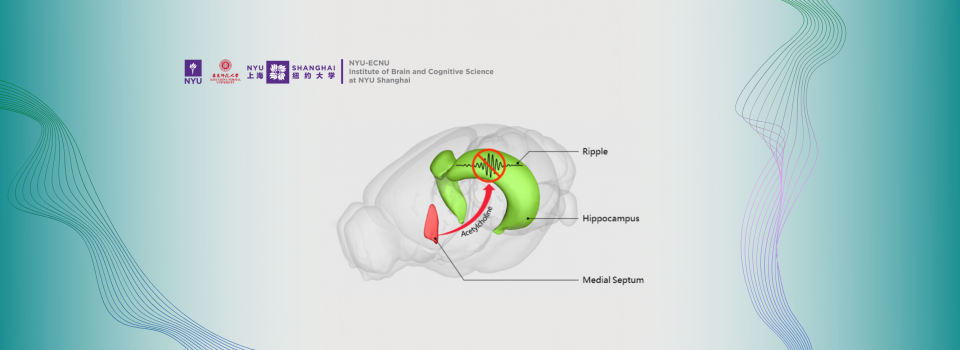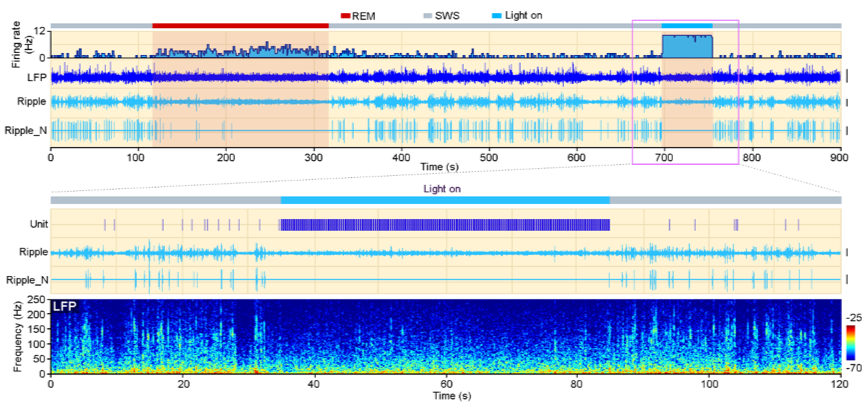May 01 2020
Published by
NYU Shanghai

The neurotransmitter Acetylcholine (ACh), which plays an essential role in neuroplasticity, sleep and arousal, learning and memory, is also one of the most important neuromodulators in the central nervous system. The hippocampus, has long been established to be crucial for memory storage and transformation. The way that ACh interacts with hippocampal neurons and modulates its function is still elusive.
A recent study published by Prof. Longnian Lin's group might shed light on such interactions. The study was recently published in the field's leading journal, the Journal of Neuroscience (2020-4-29), entitled “The Firing of Theta State-Related Septal Cholinergic Neurons Disrupt Hippocampal Ripple Oscillations via Muscarinic Receptors”. Prof. Lin's team reported, for the first time, the in vivo electro-physiological characteristics of medial septal (MS) cholinergic neurons, which sends the most abundant acetylcholine to the hippocampus. Compared with the simultaneously recorded hippocampal theta oscillations, they found that these two activities are highly correlated with each other (see figure below, blue histogram denotes the firing rates of one MS cholinergic neuron, red trace is the score of simultaneously recorded hippocampal theta oscillations).
Figure 1: The in vivo firing rate of one MS cholinergic neuron (blue histogram) coincides with hippocampal theta score (red trace) across different behavior states.
Hippocampal theta oscillations occur during animal active exploration and rapid-eye-movement sleep (REM sleep). They represent an “on-line” learning process closely related to information coding. The highly correlated firing activities of MS cholinergic neurons with hippocampal theta oscillations indicates potential role of ACh in the process of learning and memory. Can we induce artificial theta oscillation by elevating Ach concentration in the hippocampus and eventually improve memory coding?
To test this hypothesis, Prof. Lin’s team took advantage of combining optogenetic stimulation with multi-channel in vivo recording, they delivered blue light stimulation to the MS to activate cholinergic neurons during slow wave sleep (SWS) when high frequency ripple oscillation (100 – 250 Hz) dominates the local field potential (LFP). Surprisingly, activation of MS cholinergic neurons failed to induce artificial theta oscillations in the hippocampus during SWS. But instead, it completely blocked ripple oscillations (see figure below).
Figure 2 : Optogenetic stimulation of MS cholinergic neurons suppress hippocampal ripple oscillations during SWS.
Hippocampal ripple oscillations are crucial for memory consolidation. Disruption of ripple oscillations during SWS would impair hippocampal-dependent spatial memory. High concentration of Ach in the hippocampus during SWS can also suppress ripple oscillation. How does this process happen? What is the underlying mechanism of such suppression effect caused by high concentration of Ach?
To answer these questions, Prof. Lin’s team went to pharmacological experiments, looking for answers. There are two major type of cholinergic receptors in the hippocampus, muscarinic and nicotinic receptors (mAChRs and nAChRs). Intraperitoneal injection of antagonist of each receptor types proved that mAChRs, not nAChRs are involved in the process. The researchers didn’t stop there, they went one step further. There are four different subtypes of mAChRs in the hippocampus. To determine which subtype(s) facilitate(s) such process, the researchers performed intra-hippocampal micro injection of different antagonist of each muscarinic receptor subtypes. The results show that muscarinic M2 and M4 receptors, not M1 and M3 receptors participated in the cholinergic suppression of hippocampal ripple oscillations caused by optogenetic stimulation to MS cholinergic neurons.
These series of investigations focused on the in vivo firing activities of MS cholinergic neurons and their modulation of hippocampal oscillations. They show that the activity of cholinergic neurons alone was not sufficient to induce hippocampal theta oscillations. One of the important functions of acetylcholine in the hippocampus is to suppress ripples during animal exploration and REM sleep, ensuring theta dominance during such periods.
Figure 3: Illustration of acetylcholine function in the hippocampus – to suppress high frequency ripple oscillations, allowing theta oscillation to dominate.
Prof. Lin and assistant investigator Jiamin Xu are the corresponding authors of this paper. Former graduate student Xiaoyu Ma and Yiyao Zhang at East China Normal University also contributed to this paper. This work was supported by NYU-ECNU Institute of Brain and Cognitive Science at NYU Shanghai.
>> To read the article in Chinese, click here.
Source: Key Laboratory of Brain Functional Genomics, East China Normal University





